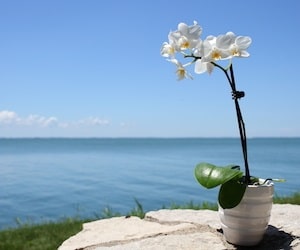Orchids love the light and temperature during the summer season. If you are keeping and growing your Orchid plants indoors, you can bring them out in a safe place under protective shades so that the flowers get to enjoy the sunlight and the warmth of the summer air for a while. In addition, orchids can be grown outside provided that they are the type that can thrive well in such an environment. Moreover, there are things that you have to consider whenever you opt to have your orchids outside. Whether you plan to use the orchids as a display to enhance your front porch or to freshen up your garden or just to have a lovely table centerpiece, consider the following factors before you move them outside:
Climate
The climate outside is one of the things that you have to consider if you want your orchids out. The climate should be at 55-75% humidity, and the higher the level of humidity is, the safer for the orchid plants to stay outside. On the other hand, it is also possible for the orchid plants to be taken outside during extremely dry climate provided that it won’t stay long outside and that there is a shade over the plant to protect it. Most orchids do not prefer full, intense sunlight and so it is best to find a spot where it can get the shades.
Cymbidium Orchids are perfect for areas and regions where climate can get 60°F and lower on summer nights. For areas with above 60°F temperature at night on summer season, growing Cattleyas and Vandas is most recommended. If you plan to leave the orchid plants outdoors, make sure it is after the frost or winter season.
Water
The orchids outside your house need water to survive the high temperature. On the other hand, the frequency and amount of water to give depend on the type or variety of orchids and on the climate or weather in the region. Generally, watering can be done at least once a week or when the roots and potting media is dry. The potting media, in addition, is also a factor when it comes to the amount of water to give and when to water the orchid plants. Between sphagnum moss and bark, bark gets easy to dry out. It the pot is still moist, do not water yet.
Light
Orchids can survive in all types and varieties of conditions. However, giving them the proper lighting system will ensure they get optimal health so that they can bloom beautifully each and every blooming season. If you are keeping the orchid plants outside of your house, make sure the each part and side is properly lighted but not directly exposed to sunlight. Some orchids with pseudobulbs prefer more light while some terrestrial types can go with minimal light. To ensure that your orchid plants will grow healthier when you place them outside, consider their type and provide them the light they require.
For potted orchids, it is easier to move and transfer the pot to a spot where the plant can get 1 to 2 hours of morning sunlight each day, and then, move it under shaded area to prevent sunburn. You may also leave the plant outside for 4 hours if you plan to plant it outdoors for good. By gradually exposing the potted plant to the outer sunlight and environment, the plant will be able to acclimate and establish in the sun and use its light for growth and development.
Potting mix
For outdoor Orchid plants, the best potting mix to use is the mixture that contains orchid moss, sand, and gravel. There are several types of potting medium suitable for the orchid plants. Most orchids are epiphytes, which mean that they are air plants and they prefer air circulation system than soil. There are orchids, though, that are terrestrial and they can grow in soil. However, most of the Orchids were originally found growing on the bark and branches of trees. The best way to grow your orchids at home, outside the house, is to recreate this habitat using the right potting mix specifically designed for them. You can use trees like palm tree, bottlebrush tree, citrus tree, and oak tree.
Bugs and Pests
In growing orchids outdoors, it is also important and necessary to watch out for bugs and pests that may harm and damage the plant. There are insects that are attracted to orchids. If you are planning to leave the plant outside of the house, always inspect the plant from insect invasion. You may find small webs from spiders, small white bumps from scale pests, and cotton-like appearance from mealy bugs. Bugs, insects, and pests can be treated easily to prevent them from damaging your orchids. You can use natural insect repellent or soap and water to wash the pests away.
Orchids originated from the tropical regions and they can naturally thrive in warm climate and humid environment. On the other hand, they are also the type of plants that are sensitive when it comes to light and moisture. Even if your location is ideal for the Orchids, it is still best to consider the weather conditions and climate outdoors, especially if you are planning to leave the Orchids outside of your house. The best way to help your plant is to keep them in pots for easy mobility. You will be able to enjoy the beauty of the plant and its blooms either inside the house or outside.
